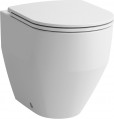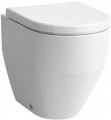Rimless
Toilets of special design, in which the bowl
has no rim.
The back of the rim is one of the worst places in the entire toilet facility: contamination and micro-organisms accumulate easily and at the same time it is difficult to get there during cleaning. In light of this, some manufacturers produce toilets without rims - this reduces the number of hard to reach places, makes the product more hygienic in general and facilitates its cleaning.
Drain (to the sewer)
The design of the outlet pipe of the toilet bowl. It determines, in particular, the features of its installation. To date, there are such options:
—
Horizontal. In such toilets, the outlet pipe is located at the back of the bowl and is oriented horizontally backwards. This is one of the most common types in Europe and the post-Soviet space - it is due to the fact that sewer pipes in these countries are drawn along the floors, and the pipe in the bathroom is usually located under the wall, behind the toilet.
—
Oblique. In fact - a kind of horizontal release (see above), in which the outlet pipe is not strictly horizontal, but at an angle (usually 30° or 45°). It will be useful in the case that the sewer pipe is low, near the floor.
—
Vertical. As the name suggests, in these toilets the output is directed vertically down. They are mainly used in the United States and other American countries, where in the construction of communications, e.g. sewerage, conducted under the floor (ceiling) without taking into account the partitions - as a result, the toilet can be placed directly above the pipe. This layout is also found in the post-Soviet space, in particular in office and production premises, as well as in residential buildings on individual projects.
—
Universal. The universal release design allows it
...to be connected to one of the three above options, depending on the specific need. Most often, the output of such toilets is hidden inside, and its own nozzle is absent; for connection selected separate pipe of the desired shape, it can go vertically, horizontally or at an angle.
It should be noted that it is theoretically possible to install a toilet with horizontal release in the bathroom under the vertical, and vice versa - but in practice, this is very difficult and actually requires the reconstruction of the toilet. And therefore, before choosing a toilet, you must clarify the design of sewer pipes in your bathroom and the most suitable type of outlet.Functions
Among the basic functions of the toilet, one can single out
circular flush of water in the bowl,
half flush,
antibacterial coating, anti-
splash, micro-lift of the
seat. More about them:
— Vortex flush (in the bowl). In toilets with a vortex flush, water flows from holes under the rim and sequentially washes the entire bowl through the formation of a characteristic water vortex. Jets of water can be directed from the outlets straight or at a slight angle: the first option is called swirling, the second – shower. The advantages of a vortex flush are low water consumption, high-quality cleaning of the toilet, absence of splashes and minimal noise levels. However, sanitary equipment with such a flush system are often more expensive than traditional solutions.
- Half drain. The ability to drain from the tank not all the water, but only a part, usually half (hence the name). It is due to the fact that a complete drain is not always required - for example, half a tank is enough to flush urine even in toilet bowls with a plate bowl (see "Bowl Shape"). This function will be useful primarily for those for whom water saving is critical (for example, if meters are installed in the apartment).
- Anti-splash. The anti-splash system prevents water splashing on the sides when the water is drained
...from the tank. Anti-splash toilets have a special bowl design. In them, the bowl is inclined, the water flowing down the inclined plane from the tank immediately goes into the sewer drain. The "anti-splash" function allows you to increase the level of hygiene and sanitation in the restroom. Toilets with an anti-drain system also have disadvantages. The main disadvantage of such models is the increased water consumption.
— Seat microlift. A device that prevents the toilet seat from hitting the rim of the bowl. It works similar to door closers: the movement of the seat is slowed down, slowing down as much as possible when approaching the rim, which ensures soft contact, prevents unpleasant popping and protects the seat and rim from damage and wear. In addition, the microlift provides additional convenience - you just need to push the seat, and it will lower itself.In box
Additional items supplied with toilet bowl.
—
Drain tank. The tank in which the water is stored for drainage. By definition comes complete with toilet comps (see. «Type»), although some of these models may have the option «without tank». But the traditional toilet bowls are very rarely sold immediately with a tank for plumbing - it is believed that this element of design in such cases is more convenient to choose separately.
—
Seat with cover. A seat for comfortable placement on the toilet, supplemented by a lid that covers the bowl in «non-working time» and keeps unpleasant odors and harmful microorganisms inside. Both seats and covers are sold separately, but it is more convenient (and sometimes cheaper) to buy them together with the toilet. Especially this configuration can be useful when buying products of non-standard form, to which it is difficult to choose third party accessories.
Weight
The total weight of the product; for compact-toilet (cf. «Type»), as a rule, is specified for standard equipment - together with «native» tank (empty).
When choosing floor models on this indicator you can not pay much attention, but for a hanging toilet bowl (see. «Installation») weight is quite principial: because the installation (or other attachment) should normally withstand both the design and the user sitting on it.

